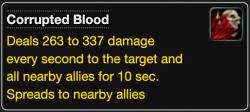Difference between revisions of "Corrupted Blood Incident"
(→Problem definition) |
(→Problem definition) |
||
| Line 12: | Line 12: | ||
The incident has helped many scientists model real-life epidemics since they would be able to draw on hard data showing how players actually responded during an outbreak. | The incident has helped many scientists model real-life epidemics since they would be able to draw on hard data showing how players actually responded during an outbreak. | ||
| − | + | '''Game vs. real-life''' | |
| + | Unlike real life, the World of Warcraft virtual environment is specific in many ways. Among the main differences important for simulating the spread of the debuff epidemic are the following: | ||
| + | * Debuff has an extremely high infectivity, spreading to all players in the spread range. | ||
| + | * Players have a defined amount of health (HP). If their health drops to zero they are moved to the cemetery in the form of a spirit. The spirit cannot interact with the environment or use action abilities. | ||
| + | * Death is not permanent. If a ghost player reaches the place of his death he can revive with a certain amount of health. | ||
| + | * A player character can have a "healer" class. Healers can use their abilities to increase the health of injured players. | ||
=Method= | =Method= | ||
Revision as of 22:38, 19 January 2021
Work in progress :)
World of Warcraft (WoW) is a massively multiplayer online role-playing game (MMORPG) released in 2004 by Blizzard Entertainment. Corrupted Blood was a virtual epidemic in the World of Warcraft an it began on 13 September 2005, when Blizzard introduced a new raid called Zul'Gurub.
Problem definition
Outbreak originated in the new dungeon Zul'Gurub and since then it is known as the "Corrupted Blood incident. Dungeon boss Hakkar was a blood god also known as the Soulflayer, who had, among his arsenal of weapons, a "debuff" spell called "Corrupted Blood." Infected players would suffer damage at regular repeating intervals, draining away their health. Debuff also damaged other near by players and rapidly spread. It was unintentionally released into the larger game world and became the first disease to affect entire servers.
The "Corrupted Blood incident" was not intentional. The biggest factor in the rapid spread of the disease was a glitch in the programming. Non-playable companions of players could became infected and could carry debuff out of the dungeon. This turned them into asymptomatic carriers and a form of vector for the debuff. As Corrupted Blood infection spread uncontrollably. During the epidemic capital cities were abandoned as players rushed to evacuate to the relative safety of the countryside, leaving urban areas filled with dead player characters.
Blizzard had to fix the problem by applying hot fixes, patches and multiple hard resets of the servers. The plague ended on 8 October 2005, when Blizzard made pets unable to be affected by Corrupted Blood debuff. Debuff could not get outside of Zul'Gurub. The incident has helped many scientists model real-life epidemics since they would be able to draw on hard data showing how players actually responded during an outbreak.
Game vs. real-life Unlike real life, the World of Warcraft virtual environment is specific in many ways. Among the main differences important for simulating the spread of the debuff epidemic are the following:
- Debuff has an extremely high infectivity, spreading to all players in the spread range.
- Players have a defined amount of health (HP). If their health drops to zero they are moved to the cemetery in the form of a spirit. The spirit cannot interact with the environment or use action abilities.
- Death is not permanent. If a ghost player reaches the place of his death he can revive with a certain amount of health.
- A player character can have a "healer" class. Healers can use their abilities to increase the health of injured players.
